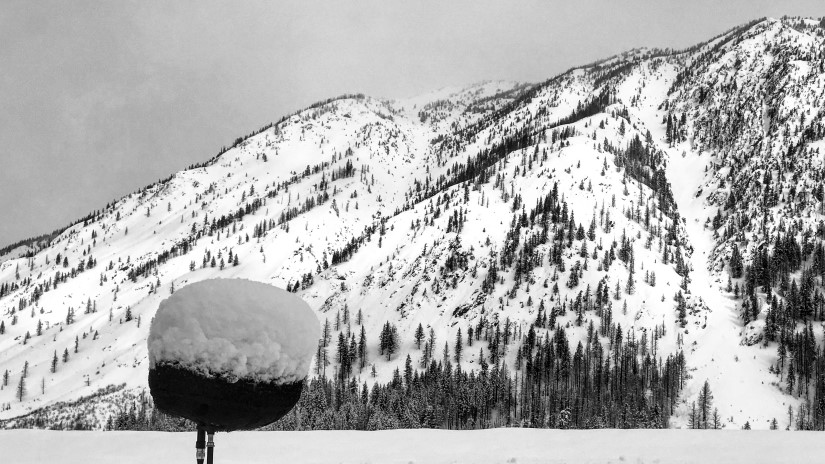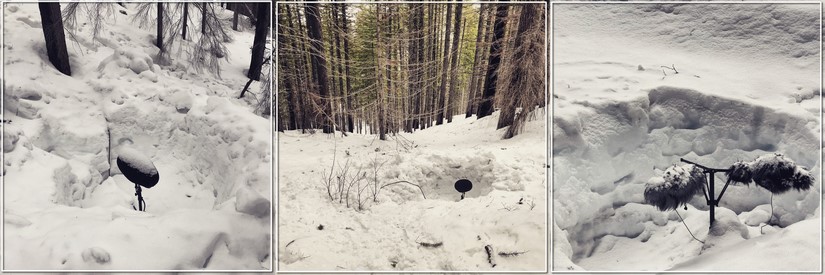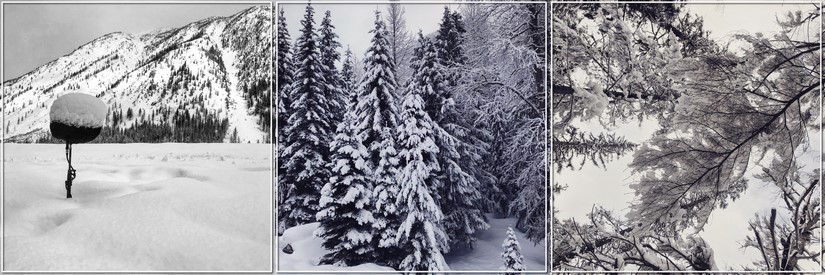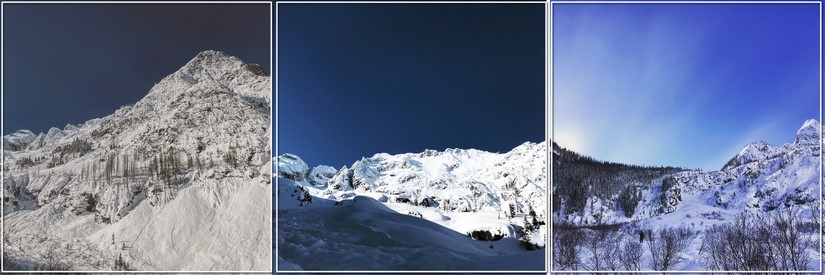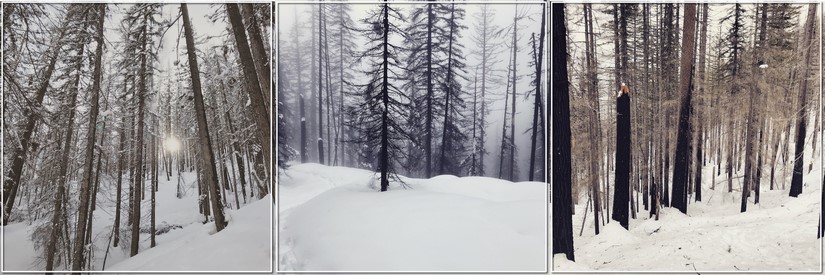Interview by Thomas Rex Beverly, photos courtesy of Thomas Rex Beverly
I spent two weeks in the Eastern Cascades of Washington in February 2020. This was my first major winter recording trip and it presented several new challenges. I learned a great deal about how to record in extreme weather conditions and I’m excited to share what I learned.
WINTER WIND PROTECTION
Recording in the snow offers unique benefits. For example, when scouting locations, I often find spots that sound lovely, but have no natural windbreaks like a rock outcrop or fallen tree.
Normally I search for a natural windbreak in wind conditions over 10 mph. However, while snowshoeing in a forest covered in 6 feet of snow, it occurred to me that I was walking on top of exactly what I needed. Using snow, I can build a wall anywhere I need! I stopped and built a snow wall in the windward direction. I didn’t have a shovel with me for the first attempt, so version 1.0 wasn’t beautiful.
Normally I search for a natural windbreak in wind conditions over 10 mph.
Come the next day, I took an avalanche shovel and the going was much easier. Then I found a squeaky tree with a wonderful eerie groan. However, there was no natural wind protection for the 30 mph gusts, so I built snow wall 2.0 and got some lovely recordings that I would otherwise have been unable to capture.
HOW TO BUILD A PSEUDO-PARABOLIC DISH OUT OF SNOW
After building snow walls for wind protection, I had another idea. Could I tune the sound of the environment by building a parabolic dish out of snow? When recording in the mountains, I often want to reduce the sound of distant water from the surrounding streams. Could I build a parabolic snow dish and focus the sound of the environment on specific sounds while minimizing others?
Could I tune the sound of the environment by building a parabolic dish out of snow?
Turns out, it works! If you build a snow cave with a diameter of about 6 feet it does wonders to reduce unwanted sounds below about 2,000 Hz. It also focuses on the sounds of events in close proximity. This is not a true parabolic dish, but to my ears the curve of the snow wall does increase the focus of sounds in the direction of the arc and reduce unwanted sounds to the rear.
There is one tradeoff to this strategy; reduced sound from the rear when recording in surround. When recording with my Double Mid/Side rig the snow wall dampens the sound of the rear microphone. However, this is often a tradeoff I am willing to make in order to reduce the sounds of distant water and protect the microphones from the wind. By reducing the sound of the distant water I was able to focus my recordings on the extremely quiet sounds of winter in the Eastern Cascades. I was also able to get some insanely powerful winds with absolutely no buffeting of the microphones.
Hear the power of the wind
DOES FALLING SNOW MAKE A SOUND?
In perfect conditions, falling snow sounds like delicate crystalline rain. An extremely quiet environment is needed to hear or record it. This can be tricky because wind often accompanies snowfall. It also takes a moderate density of snow to create the sound. Sparse, slowly floating flakes aren’t heard because they land so lightly, but once you get moderate flurries an amazing sound of crystalline rain appears. It is such a soothing and wonderful sound. I also love the variation in the sound caused by different types of snow; the plop of big wet flakes and the delicate clinking crystals of powdery particles.
Much like rain, wet snow can create a thump on the microphone blimp, so it is best to find a natural rain/snow cover or to build your own. I like to find a low overhanging branch, or you can build a canopy using the local foliage.
George Vlad has a great video on how to do just that –
How to record rain sounds
SNOW HURRICANES and TREE-ALANCHES
I’ve recorded canopy winds all over North America. These sounds usually consist of long sweeping gusts with the character of the forest foliage. In general, the larger the foliage the lower the pitch of the wind. Short-needled conifers create wind with more mid-range frequencies whereas long needled conifers will have more of a low-end roar. This can sound like the mid-range sweeps of short-needled Douglas Fir and Spruce, or the low roars of long-needled Ponderosa Pine. However, wind in a snowy forest is a whole other animal and it has become one of my new favorite natural sounds.
What does it sound like when 50 mph winds sweep through a winter forest covered in wet snow? It sounds like a snow hurricane. Imagine wind roaring down the valley in long 30-second swells. When the gust finally arrives in the local canopy, debris flies everywhere. Hundreds of trees drop their loads of snow and ice with puffs of powder and meaty thumps. Trees begin to squeal as they struggle to stay vertical and hundreds of small branches break and fly to the ground to add to the mayhem.
When enough snow is sloughing off branches the forest turns into a giant plucked wood instrument.
My favorite part of this windy cacophony is when falling snow plucks small dead branches on its way down. Each plucked branch pops with a slightly different pitch! When enough snow is sloughing off branches the forest turns into a giant plucked wood instrument. This sound can also be triggered when direct sunlight crests a ridge top and instantly melts the forest canopy. These “tree-alanches” are an amazing sound of winter.
Hear a snow hurricane starting at 3:30
THE ROAR OF AVALANCHES
***Disclaimer – learn about winter safety before attempting to record avalanches. This type of recording can be extremely dangerous. Consult a local expert and learn how to travel and record safely in winter conditions.
A local mountaineer took me out snowshoeing in the Eastern Cascades. We hiked up into a large basin with majestic mountains on all sides. As we sat to eat lunch, the sun crested the ridge line and hit the massive cliff face to our west. It began to crack and groan. After a few minutes, the energy of the sun triggered a series of avalanches! I was in awe for the first slide and then scrambled to set up my mics. Avalanches were happening every 5-10 minutes! It was an amazing experience to watch and hear.
Avalanches were happening every 5-10 minutes! It was an amazing experience to watch and hear.
Some avalanches had a powdery sound, almost like sand while others sounded like refrigerator-sized chunks of ice tumbling down a mountain face. Others had a roar like distant thunder.
I was amazed at the length of the event, as most avalanches last 30-90 seconds. Some started with a rumble, others with a sharper crack, and all had long, decaying tails as the snow and ice tumbled down the mountain side.
That day had an incredibly rare set of conditions. The danger of larger avalanches was low, but the sun was triggering smaller slides that I could record from a safe distance. I was lucky to experience this afternoon of avalanches and was incredibly thankful to have had a chance to hear the power of this captivating natural event. It is similar to experiencing a tornado or wildfire.
My Double Mid/Side drop-and-record rig was left in the woods in various locations recording for 10 days. During that time, I was lucky to capture two large avalanches. Capturing an isolated recording of a large avalanche is incredibly difficult. It is problematic to leave a drop rig close enough to an avalanche chute to get good recordings while also far enough away that it won’t get buried in tons of snow.
In addition, a windless night is needed so that gusts are not masking the low roar of the avalanche.
After days of waiting, I got lucky and a gigantic slide happened about a quarter mile from my mics. It has a lush guttural roar with an immense natural power.
Hear the power of sliding snow
WINTER HOOTS
Great Horned and Barred Owls are winter nesters so they start looking for a mate and a place to nest in snowy forests. This makes February a perfect time to catch some lovely owl duets as they call to each other. I was lucky to catch some lovely Great Horned owls and a Barred Owl on still nights. The Great Horned Owls sing a lovely duet, but the Barred Owl sings it’s lonely call into the night with no response.
Hear owl duets at 1:10
NATURE ROOMTONES IN WINTER FORESTS
Natural spaces have a roomtone just like cathedrals or concert halls. For indoor spaces, the sound is often lighting or HVAC systems. Outdoors, a very light wind is needed to resonate the space and give it an airy tone. If the outdoor space is totally still, all that is recorded is the self-noise of the microphones and recorder preamps so I search for resonant spaces with barely audible wind and distant soothing water. This could be a whispering branch squeak, tranquil canopies gently drifting, or the swish of distant wind cresting ridgetops. I love the subtle sound of this silence.
Hear forest roomtones
WINTER RECORDING TIPS:
Q: How do you record falling snow without ruining your recording gear?
A: I use the same strategies I use for recording rain. You can learn more about rain recording from a Tonebenders interview, or my blog post on Alaskan rain.
Q: How do you keep batteries working in cold conditions?
A: Bury the recorder and dry bag in the snow for drop-and-record sessions. Snow is mostly air and acts as an excellent insulator. I found that the combination of the heat created by the Sound Devices MixPre-6 or MixPre-3 II and the insulation of the snow is enough to keep the USB-C batteries running well in temperatures down to 10° F. I only saw a 5-10% performance loss on overnight recording sessions in those conditions.
Buy USB batteries that are larger than you need when recording in cold conditions. If the battery is charged above 50% it will likely still work in very cold conditions. If the charge dips below 50% it will likely die when it gets cold. For example, I run my Sony A10 off a 20,000 mAh USB-A battery for long drop rig recording sessions. The A10 can run for several days off the first 50% of that battery.
Q: How do you change drop-rig batteries and SD cards in a blizzard?
A: Previously, I’ve used a large umbrella to cover myself during rainstorms. This works reasonably well in the rain, but is not ideal in blowing snowstorms. I realized it is much better to use a tent’s rainfly of at least 8 x 12 feet. With that large tarp, I can cover my body and all the gear without any danger of getting a stray snowflake into my electronics. This works extremely well and I was able to change batteries in almost whiteout snow conditions.
Q: What if it snows 6 feet in one night?
A: This can happen in unpredictable mountain conditions, so make sure your tripod is high enough off the ground so that the blimp doesn’t get totally buried in the snow. If you’ve waterproofed your Cinela blimp (read more on how to do that – here), the mics would probably be fine, but if the whole rig is buried in 6 feet of snow, it could be difficult to locate. Make sure you have a GPS location recorded on where you left your mics and pay serious attention to snowfall predictions. I love my Garmin inReach mini because I can get accurate local weather predictions by satellite when I am off the grid.
Experiment with building wind walls and parabolic dishes out of snow. Using the snow to tune the sound of the environment can yield wonderful results.
I hope you enjoy the subtle sounds of winter in the Eastern Cascades of Washington. This recording trip was an awe-inspiring and restful time for me. I hope you love these sounds as much as I loved recording them.
Thanks for listening,
Tom
The Pacific Northwest Sound Library Series:
-
Select options This product has multiple variants. The options may be chosen on the product page
-
Select options This product has multiple variants. The options may be chosen on the product page
-
Select options This product has multiple variants. The options may be chosen on the product page
-
Select options This product has multiple variants. The options may be chosen on the product page
-
Select options This product has multiple variants. The options may be chosen on the product page
A big thanks to Thomas Rex Beverly for giving us a behind-the-scenes look at capturing the Sounds of Snowstorms and Avalanches!









































































































































































































































